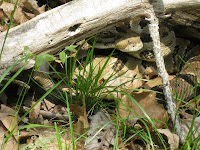 |
| Trilllium sessile |
Valley Water Mill is a park with a lot of history. There are scattered shards of flint testifying to the long use of the spring and stream by Native Americans. Early settlers valued its water and it became an early municipal water supply for the city of Springfield. This made it an obvious choice for locating the Watershed Center, an educational outreach of the Watershed Committee of the Ozarks.
Newly graduated Master Naturalists are expected to complete a capstone project, designed to get their feet wet (sometimes literally) in volunteer activities. For Linda, a botanical illustrator and botanist, a plant survey at Valley Water Mill (VWM) was a logical choice. She could involve others needing a capstone as well as teach a group some plant identification skills.
The
trail around the lake at VWM is a gem, winding through wetlands, up through woodlands and along a ridge overlooking the lake. There are stops along the way to see the spring, a karst window and a bluff outlook. Bob R. generously shared his bug spray and suntan lotion as tick, chigger and sunburn season is here. Alane supplied walking sticks and the No MO Trash bag. Linda had a resource library in her head and left the heavy Steyermarks in the car for future reference. Bob was assigned the position of recorder and pack mule and Mary became the specimen "bag lady."
All eyes began searching for something blooming. We spotted the first one along the curb- Yellow Rocket (
Barbarea vulgaris), an opportunistic, prolific of the mustard family (
Brassicaceae). Alane, Kathryn, Mary and Barb enthusiastically yanked them from the moist soil. An edible, Barb uses the leaves sparingly in rice dishes as the mustard tang is strong.
Plant specimens were placed in plastic bags for specific species keying out by Linda. The park trail has been disturbed and untended for many decades so invasives are abundant - Japanese and Bush Honeysuckle (
Lonicera of Asian kinds) and Winter Creeper (
Euonymus hederaceus) as well as Reed Canary Grass in the wetlands. Not blooming but very recognizable, rapidly growing Poison Hemlock (
Conium maculatum) of the prolific carrot family (
Apiaceae) also got yanked when solo plants were found.
Soon everyone was spotting the pink, purple and white flowers of exotic winter annual weeds - the Eurasian Dead Nettle (Lamium purpureum) and Henbit (Lamium amplexicaule) of the mint family, Poor Man's Pepper (
Lepidium) of the mustard family, Chickweeds, and Speedwell (
Vernonica). Although non-native, they add to the beauty of the woodland floor. This is their moment in the sun.
Looking for natives in the wetland, Linda pointed out the leaves of Elderberry. Marlyss spotted some wild ginger and Barb lifted up the leaves to show everyone the brown-maroon flower underneath. Linda continued a non-stop flow of botanical erudition. Did you know that brown flowers, such as the small wild ginger blossom or our common
Trillium_sessile (pictured above) do not have dedicated pollinators such as bees and butterflies? They smell like rotting fruit, drawing flies and beetles which then spread their pollen to their neighbors.
In the glade the team found other natives -forbs commonly named Rue Anemone, False Rue Anemone, Violets, and Toothwort. There were flowering bushes and small trees: Fragrant Sumac,
Viburnum, Bladder Nut trees
(Staphylea trifolia), Red Bud, and Dogwood. David pointed to the mottled leaves of Trout Lily; they had already bloomed and were developing seed. Bob R. found False Solomon's Seal foliage and a small pendular bird nest on a broken tree branch. Stephanie found the Mayapples whose most senior two leafed plants were forming flowers under the umbrella-like leaves. The smallest wildflower was found last, on the slope by the dam - a Johnny Jump Up. Along the lake the Wild Cherry was blooming.
We finished the afternoon in the shelter house with a high magnification lesson on identifying mints and mustards, the perfect spice on a great capstone, all in the name of science.
This is the first of a series of monthly surveys designed to create a plant database of the park. It builds on the species documented during an Audubon and Master Naturalist bioblitz from 2008.




































